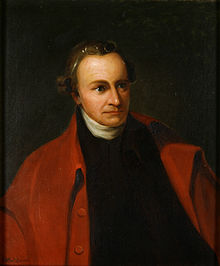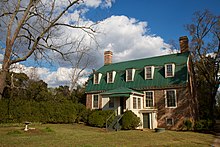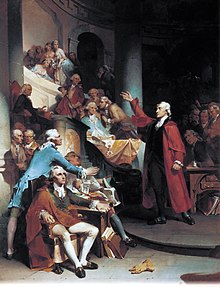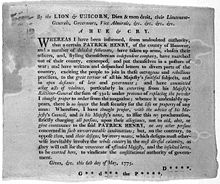| Revision as of 16:08, 18 May 2011 view source65.51.107.196 (talk) →Monuments and memorials← Previous edit | Revision as of 16:31, 18 May 2011 view source AlexiusHoratius (talk | contribs)Administrators61,597 editsm Reverted edits by 65.51.107.196 (talk) to last version by ClueBot NGNext edit → | ||
| Line 93: | Line 93: | ||
| Monuments are located at his home and grave site, designated ]. | Monuments are located at his home and grave site, designated ]. | ||
| At least three ships have been named in his honor: the Civil War ] ] {{ship|CSS|Patrick Henry}}, the first ] ] launched, {{SS|Patrick Henry}}, and ] {{USS|Patrick Henry|SSBN-599}}. Also named in his honor, ] in ], eight high schools (including three in Virginia, more than for any other person in the Commonwealth), and ] in ]. The Patrick Henry Boys and Girls Plantation was established as a living legacy to Patrick Henry on property near his grave site donated by the Red Hill Patrick Henry National Memorial. It is a Christian residential facility for ]. Henry helped to establish the ] in Virginia. It is the 10th-oldest institution of higher education in the United States. Six of Patrick Henry's sons graduated from Hampden-Sydney. The Patrick Henry Scholars are named for him. Future United States president ] also graduated from the College in 1791. | |||
| Fort Patrick Henry was a colonial fort built during the ] along the ] at the present-day site of ]. This fort serves as the namesake of ] and the reservoir that it forms on the river.<ref>{{cite web|url=http://www.tva.com/sites/fortpatrickhenry.htm|title=Fort Patrick Henry Reservoir|publisher=Tennessee Valley Authority|accessdate=2008-10-28}}</ref> ] was a United States Army base from late 1942 to the late 1960s and was a {{convert|1700|acre|km2|sing=on}} complex in ]. Since decommissioned, it is the site of the ] on {{convert|925|acre|km2}} of the old location. The airport opened in 1949 and was originally called Patrick Henry Field. The airport code is still PHF for the beginning letters of the old name. | Fort Patrick Henry was a colonial fort built during the ] along the ] at the present-day site of ]. This fort serves as the namesake of ] and the reservoir that it forms on the river.<ref>{{cite web|url=http://www.tva.com/sites/fortpatrickhenry.htm|title=Fort Patrick Henry Reservoir|publisher=Tennessee Valley Authority|accessdate=2008-10-28}}</ref> ] was a United States Army base from late 1942 to the late 1960s and was a {{convert|1700|acre|km2|sing=on}} complex in ]. Since decommissioned, it is the site of the ] on {{convert|925|acre|km2}} of the old location. The airport opened in 1949 and was originally called Patrick Henry Field. The airport code is still PHF for the beginning letters of the old name. | ||
Revision as of 16:31, 18 May 2011
For other people named Patrick Henry, see Patrick Henry (disambiguation).| Patrick Henry | |
|---|---|
 | |
| 1st & 6th Governor of Virginia | |
| In office July 5, 1776 – June 1, 1779 | |
| Preceded by | John Murray (Colonial Governor) |
| Succeeded by | Thomas Jefferson |
| In office December 1, 1784 – December 1, 1786 | |
| Preceded by | Benjamin Harrison V |
| Succeeded by | Edmund Randolph |
| Personal details | |
| Born | May 29, 1736 Hanover County, Virginia |
| Died | June 6, 1799(1799-06-06) (aged 63) Brookneal, Virginia |
| Political party | Anti-Federalist Anti-Administration Federalist |
| Spouse(s) | Sarah Shelton Dorothea Dandridge |
| Profession | Planter Lawyer |
| Signature |  |
Patrick Henry (May 29, 1736 – June 6, 1799) was an orator and politician who led the movement for independence in Virginia in the 1770s. A Founding Father, he served as the first and sixth post-colonial Governor of Virginia from 1776 to 1779 and subsequently, from 1784 to 1786. Henry led the opposition to the Stamp Act of 1765 and is well remembered for his "Give me Liberty, or give me Death!" speech. Along with Samuel Adams and Thomas Paine, he is remembered as one of the most influential exponents of Republicanism, promoters of the American Revolution and Independence, especially in his denunciations of corruption in government officials and his defense of historic rights. After the Revolution, Henry was a leader of the anti-federalists in Virginia who opposed the United States Constitution, fearing that it endangered the rights of the States, as well as the freedoms of individuals.
Early years
Henry was born in Studley, Hanover County, Virginia on May 29, 1736. His father was John Henry, an immigrant from Aberdeenshire, Scotland, who had attended King's College, Aberdeen before immigrating to the Colony of Virginia in the 1720s. Settling in Hanover County, about 1732 John Henry married Sarah Winston Syme, a wealthy widow from a prominent Hanover County family of English ancestry. Patrick Henry was once thought to have been of humble origins, but he was actually born into the middle rank of the Virginia gentry.

Henry attended local schools for a few years, and then was tutored by his father. After failing in business, in 1754 he married Sarah Shelton, with whom he would have six children. As a wedding gift his father-in-law gave the couple six slaves and the 300-acre (1.2 km) Pine Slash Farm. Henry began a career as a planter, but their home was destroyed by fire in 1757. Henry made another attempt at business,which also failed, before deciding to become a lawyer in 1760.
Henry first made a name for himself in a case dubbed the "Parson's Cause" (1763), which was an argument about whether the price of tobacco paid to clergy for their services should be set by the colonial government or by the Crown. After the British Parliament overruled Virginia's Two Penny Act that had limited the clergy's salaries, the Reverend James Maury filed suit against the vestry of Louisa County for payment of back wages. When Maury won the suit, a jury was called in Hanover County to determine how much Maury should be paid. Henry was brought in at the last minute to argue on behalf of Louisa County. Ignoring legal niceties, Henry delivered an impassioned speech that denounced clerics who challenged Virginia's laws as "enemies of the community" and any king who annulled good laws like the Two Penny Act as a "tyrant" who "forfeits all right to his subject's obedience". Henry urged the jury to make an example of Maury. After less than five minutes of deliberation, they awarded Maury one penny. The Hanover County Courthouse where Patrick Henry argued the Parson's Cause still remains an active courthouse; located along historic U.S. Route 301, the courthouse sits adjacent Hanover Tavern (rebuilt in 1791 after burning) where Patrick Henry lodged amid arguing the Parson's Cause. The courthouse is the third oldest courthouse still in use in the United States.
Stamp Act
Patrick Henry was elected from Louisa County to the House of Burgesses, the legislative body of the Virginia colony, in 1765 to fill a vacated seat in the assembly. When he arrived in Williamsburg the legislature was already in session. Only nine days after being sworn in, Henry introduced the Virginia Stamp Act Resolutions, "in language so extreme that some Virginians said it smacked of treason".

The new representative waited for an opportunity where the mostly conservative members of the House were away (only 24% was considered sufficient for a quorum). In this atmosphere, he succeeded, through much debate and persuasion, in getting his proposal passed. It was possibly the most anti-British American political action to that point, and some credit the Resolutions with being one of the main catalysts of the Revolution. The proposals were based on principles that were well-established British rights, such as the right to be taxed by one's own representatives. They went further, however, to assert that the colonial assemblies had the exclusive right to impose taxes on the colonies and could not assign that right. The imputation of treason is due to his inflammatory words, "Caesar had his Brutus; Charles the First his Cromwell; and George the Third ....may he profit by their example. If this be treason, make the most of it!"
According to biographer Richard Beeman, the legend of this speech grew more dramatic over the years. Henry probably did not say "If this be treason, make the most of it." The only account of the speech written down at the time by an eyewitness (which came to light many years later) records that Henry actually apologized after being accused of uttering treasonable words, assuring the House that he was still loyal to the king. Nevertheless, Henry's passionate, radical speech was cause for notable interest at the time–even if his exact words are unknown.
Sarah's illness
In 1771 Patrick and his wife Sarah moved into their Scotchtown estate along with their children: Martha ("Patsy"), Anne, Elizabeth ("Betsy"), John, William, and Edmund ("Neddy"). Sarah "started to manifest disturbing behaviors which could not at that time be diagnosed or treated. ...her mental condition deteriorated rapidly, and when she became dangerous to herself and others, she was clothed in a 'Quaker shirt,' an early form of strait jacket."
Following the general practice of the time, Patrick's friends and his physician, Dr. Thomas Hinde, advocated she be moved to the public hospital in Williamsburg. But after inspecting the facilities Patrick "saw that if he agreed, his wife would be locked into a windowless brick cell containing only a filthy mattress on the floor and a chamber pot. There she would be chained to the wall with a leg iron. Appalled by what he saw, he instead prepared a private, two-room apartment for her in the basement of Scotchtown. Each room had a window, providing light, air circulation, and a pleasant view of the grounds. The apartment also had a fireplace, which provided good heat in the winter, and a comfortable bed to sleep in."
Patrick himself (or a slave when he was away on business) took care of Sarah and "watched over her, fed her, bathed her, clothed her, and prevented her from harming herself." Sarah died in the spring of 1775 "Because of her illness-then thought to have been caused by being 'possessed by the devil' - she was denied a religious funeral service or a Christian burial. Her grieving husband, 'bowed down and bleeding under the heaviest sorrows and personal distresses,' buried her thirty feet from the home they shared and planted a lilac tree next to her grave to remember her. The tree still stands there, a few steps from the door to her basement."
American Revolution
Responding to pleas from Massachusetts that the colonies create committees of correspondence to coordinate their reaction to the British, Henry took the lead in Virginia. In March 1773, along with Thomas Jefferson and Richard Henry Lee, Henry led the Virginia House of Burgesses to adopt resolutions providing for a standing committee of correspondents. Each colony set up such committees, and they led to the formation of the First Continental Congress in 1774, to which Henry was elected.
Patrick Henry is best known for the speech he made in the House of Burgesses on March 23, 1775, in Saint John's Church in Richmond, Virginia. The House was undecided on whether to mobilize for military action against the encroaching British military force, and Henry argued in favor of mobilization. Forty-two years later, Henry's first biographer, William Wirt, working from oral testimony, attempted to reconstruct what Henry said. According to Wirt, Henry ended his speech with words that have since become immortalized:
"Is life so dear, or peace so sweet, as to be purchased at the price of chains and slavery? Forbid it, Almighty God! I know not what course others may take; but as for me, Give me Liberty, or give me Death!"
The crowd, by Wirt's account, jumped up and shouted "To Arms! To Arms!". For 160 years Wirt's account was taken at face value, but in the 1970s historians began to question the authenticity of Wirt's reconstruction. Historians today observe that Henry was known to have used fear of Indian and slave revolts in promoting military action against the British, and that according to the only written first-hand account of the speech, Henry used some graphic name-calling that failed to appear in Wirt's heroic rendition.
In August 1775, Henry became colonel of the 1st Virginia Regiment. At the outset of the Revolutionary War, Henry led militia against Royal Governor Lord Dunmore in defense of some disputed gunpowder, an event known as the Gunpowder Incident. During the war he served as the first post-colonial Governor of Virginia and presided over several expeditions against the Cherokee Indians, who were allied with the British.

Henry lived during part of the War at his 10,000-acre (40 km) Leatherwood Plantation in Henry County, Virginia, where he, his first cousin Ann Winston Carr and her husband Col. George Waller had settled. During the five years Henry lived at Leatherwood, from 1779 to 1784, he owned 75 slaves, and grew tobacco. During this time, he kept in close touch with his friend the explorer Joseph Martin, whom Henry had appointed agent to the Cherokee nation, and with whom Henry sometimes invested in real estate, and for whom the county seat of Henry County was later named.
In early November 1775 Henry and James Madison were elected founding trustees of Hampden-Sydney College, which opened for classes on November 10. He remained a trustee until his death in 1799. Henry was instrumental in achieving passage of the College's Charter of 1783, an action delayed because of the war. He is probably the author of the Oath of Loyalty to the new Republic included in that charter. Seven of his sons attended the new college.
On October 25, 1777, Patrick Henry married his second wife, Dorothea Dandridge (1755–1831). From this marriage came eleven children.
Later years
After the Revolution, Henry again served as governor of Virginia from 1784 to 1786, but declined to attend the Constitutional Convention of 1787 saying that he "smelt a rat in Philadelphia, tending toward the monarchy." An ardent supporter of state rights, Henry was an outspoken critic of the United States Constitution and led the Virginia opposition to its ratification arguing that it gave the federal government too much power and that the untested office of the presidency could devolve into a monarchy. As a leading Antifederalist, he was instrumental in forcing the adoption of the Bill of Rights to amend the new Constitution and became a leading opponent of James Madison.

Henry served as a representative to the Virginia convention of 1788 that ratified the U. S. Constitution. He voted against ratification. He was chosen as an elector for the 1789 election from Campbell District. That District consisted of Bedford County, Campbell County, Charlotte County, Franklin County, Halifax County, Henry County, Pittsylvania County, and Prince Edward County, which cover the area between Danville and Lynchburg in the south of Virginia All of the 10 electors who voted cast one of their two votes for George Washington. Five of them cast their other vote for John Adams. Three cast theirs for George Clinton. One cast his for John Hancock. One cast his for John Jay. Clinton was a leading Antifederalist, a view which he shared with Henry.
President George Washington offered Henry the post of Secretary of State in 1795, which he declined out of opposition to Washington's Federalist policies. However, following the radicalism of the French Revolution Henry's views changed as he began to fear a similar fate could befall America and by the late 1790s, Henry was in support of the Federalist policies of Washington and Adams. He especially denounced the Virginia and Kentucky Resolutions, which had been secretly written by Jefferson and Madison, and approved by the legislatures of those two states. He warned that civil war was threatened because Virginia, "had quit the sphere in which she had been placed by the Constitution, and, in daring to pronounce upon the validity of federal laws, had gone out of her jurisdiction in a manner not warranted by any authority, and in the highest degree alarming to every considerate man; that such opposition, on the part of Virginia, to the acts of the general government, must beget their enforcement by military power; that this would probably produce civil war, civil war foreign alliances, and that foreign alliances must necessarily end in subjugation to the powers called in." In 1798 President John Adams nominated Henry special emissary to France, but he had to decline because of failing health. He strongly supported John Marshall and at the urging of Washington stood for and was elected to the Virginia House of Delegates as a Federalist. However, three months prior to taking his seat in the state legislature, he died of stomach cancer on June 6, 1799, while at Red Hill, his family's large plantation. Following his death, Henry's widow remarried the Virginia governor's first cousin and executor Judge Edmund Winston.

Honored on US Postage

- Few people in early American history other than American Presidents have been honored on US postage stamps, and Patrick Henry is prominent among them.
- On October 7, 1955, the US Post Office issued a 1-dollar postage stamp honoring the famous orator and long time Governor of Virginia. It was one in a series of twenty seven stamps in the Liberty issue. A painting of Henry by American artist Alonzo Chappel (1828-1887) was used as the inspiration and as the model by the engraver for this issue.
- In 1960, the US Post Office issued the CREDO Issue, a series of six stamps with famous quotes engraved on the face of each one. Patrick Henry's most famous words are inscribed on the front of this 4-cent issue, first released in Richmond, Virginia, on January 11, 1961. -- See also: US Presidents on US postage stamps
Monuments and memorials

Monuments are located at his home and grave site, designated Red Hill Patrick Henry National Memorial.
At least three ships have been named in his honor: the Civil War Confederate Navy steamboat CSS Patrick Henry, the first World War II Liberty ship launched, SS Patrick Henry, and ballistic missile submarine USS Patrick Henry (SSBN-599). Also named in his honor, Emory & Henry College in Emory, Virginia, eight high schools (including three in Virginia, more than for any other person in the Commonwealth), and Patrick Henry College in Purcellville, Virginia. The Patrick Henry Boys and Girls Plantation was established as a living legacy to Patrick Henry on property near his grave site donated by the Red Hill Patrick Henry National Memorial. It is a Christian residential facility for at-risk youth. Henry helped to establish the Hampden-Sydney College in Virginia. It is the 10th-oldest institution of higher education in the United States. Six of Patrick Henry's sons graduated from Hampden-Sydney. The Patrick Henry Scholars are named for him. Future United States president William Henry Harrison also graduated from the College in 1791.
Fort Patrick Henry was a colonial fort built during the American Revolutionary War along the South Fork Holston River at the present-day site of Kingsport, Tennessee. This fort serves as the namesake of Fort Patrick Henry Dam and the reservoir that it forms on the river. Camp Patrick Henry was a United States Army base from late 1942 to the late 1960s and was a 1,700-acre (6.9 km) complex in Newport News, Virginia. Since decommissioned, it is the site of the Newport News/Williamsburg International Airport on 925 acres (3.74 km) of the old location. The airport opened in 1949 and was originally called Patrick Henry Field. The airport code is still PHF for the beginning letters of the old name.

Other places named in honor of Patrick Henry include Henry County, Virginia, Henry County, Kentucky, Patrick County, Virginia, Henry County, Georgia, Henry County, Ohio, Henry County, Tennessee, Henry County, Alabama, Henry County, Illinois, Henry County, Missouri after an 1841 name change, and Patrick Henry Village in Heidelberg, Germany.
See also
Notes
- ^ Thad Tate, "Henry, Patrick", American National Biography Online, February 2000.
- Meade, Patrick Henry, 13–18.
- Meade, Patrick Henry, 1:21–24.
- Meade, Patrick Henry, 1:133
- Beeman, Patrick Henry, 16–19; Middlekauff, Glorious Cause, 82–83; Meade, Patrick Henry, 1:125–34.
- T.H. Breen, "Tobacco Culture: The Mentality of the Great Tidewater Planters on the Eve of Revolution," (1985), page 189
- ^ Richard N. Côté (2005). Strength and honor: the life of Dolley Madison. Corinthian Books.
- Judy Hemple, "The Textual and Cultural Authenticity of Patrick Henry's 'Liberty or Death' Speech," Quarterly Journal of Speech 63 (1977): 298-310; see Ray Raphael, Founding Myths, 311 note 7 for additional discussions among historians.
- Raphael, Founding Myths, 145-156, 311-313.
- The True Patrick Henry, George Morgan, Lippincott, New York, 1907. Books.google.com. 2007-07-17. Retrieved 2010-03-19.
- A Son of Thunder: Patrick Henry and the American Republic, Henry Mayer, Grove Press, New York, 2001. Books.google.com. Retrieved 2010-03-19.
- "Elliot's Debates: Virginia Ratifying Convention: June 27, 1788". Teachingamericanhistory.org. 1980-01-01. Retrieved 2010-03-19.
- The Documentary history of the first Federal elections, 1788-1790, by Gordon DenBoer, Volume 2, page 303
- "View Election". Elections.lib.tufts.edu. 2007-10-18. Retrieved 2010-03-19.
- The Documentary history of the first Federal elections, 1788-1790, by Gordon DenBoer, Volume 2, pages 304-5
- "Anti-Federalist Papers". Angelfire.com. Retrieved 2010-03-19.
- Tyler, Patrick Henry pp413-420
- Patrick Henry's Family, Redhill.org
- Smithsonian National Postal Museum
- ^ Scott's US Stamp Catalogue, Identifier
- Credo Issue of 1961, Smithsonian National Postal Museum
- "Fort Patrick Henry Reservoir". Tennessee Valley Authority. Retrieved 2008-10-28.
References
- Beeman, Richard R. (1974). Patrick Henry: A Biography. New York: McGraw-Hill. ISBN 0070042802.
{{cite book}}: Cite has empty unknown parameter:|coauthors=(help) - Jewett, Thomas. "Patrick Henry: America's Radical Dissenter" Early America Review Summer/Fall 2004
- Mayer, Henry (2001). Son of Thunder: Patrick Henry and the American Republic. New York: Grove Press.
{{cite book}}: Cite has empty unknown parameter:|coauthors=(help) - Meade, Robert D. (1957–1969). Patrick Henry: 2 volumes.
{{cite book}}: Cite has empty unknown parameter:|coauthors=(help)CS1 maint: date format (link) - Raphael, Ray (2004). Founding Myths: Stories that Hide Our Patriotic Past. New York: The New Press. ISBN 1565849213.
{{cite book}}: Cite has empty unknown parameter:|coauthors=(help) - Unger, Harlow (2010). www.harlowgilesunger.com Lion of Liberty: Patrick Henry and the Call To a New Nation. Cambridge: Da Capo Press. ISBN 9780306818868.
{{cite book}}: Check|url=value (help); Cite has empty unknown parameters:|1=and|coauthors=(help)
External links
- Patrick Henry Timeline from Patrick Henry National Memorial
- Patrick Henry, Voice of the American Revolution, patrickhenry.com
- Works by Patrick Henry at Project Gutenberg
- Quotations by Patrick Henry at Liberty-Tree.ca
- Text of 1775 "Liberty or death" speech
- Address opposing US Constitution
- Patrick Henry at Find-A-Grave
- Patrick Henry Letters
- Patrick Henry Monument, Henry County, Virginia, virginia.org
- "Scotchtown". "Scotchtown". Scotchtown Plantation, Henry family home from 1771–1778
- Archival Records
| Political offices | ||
|---|---|---|
| Preceded byEdmund Pendleton | Governor of Virginia 1776–1779 |
Succeeded byThomas Jefferson |
| Preceded byBenjamin Harrison V | Governor of Virginia 1784–1786 |
Succeeded byEdmund Randolph |
- 1736 births
- 1799 deaths
- People from Hanover County, Virginia
- American people of Scottish descent
- American people of English descent
- Anti-Federalists
- Cancer deaths in Virginia
- Clan Henderson
- Continental Congressmen from Virginia
- Deaths from stomach cancer
- Governors of Virginia
- House of Burgesses members
- People from Henry County, Virginia
- People from Charlotte County, Virginia
- People from Louisa County, Virginia
- People of Virginia in the American Revolution
- Virginia lawyers
- Virginia militiamen in the American Revolution


